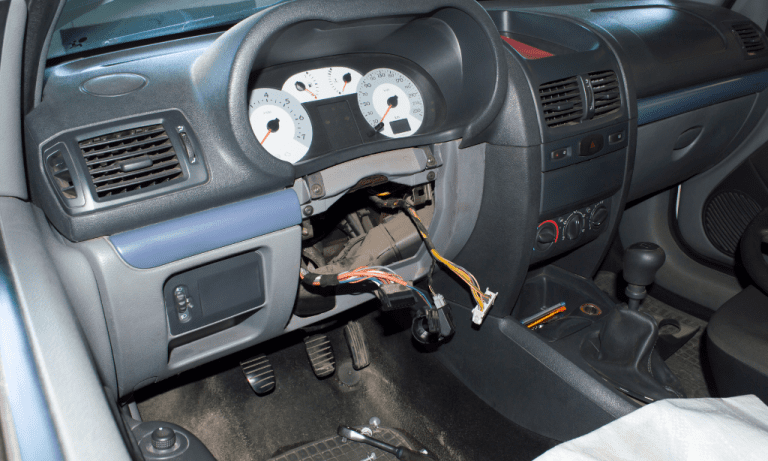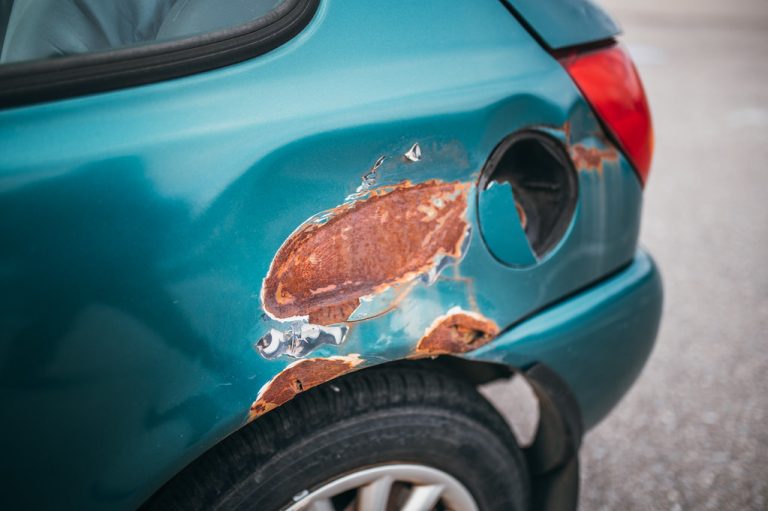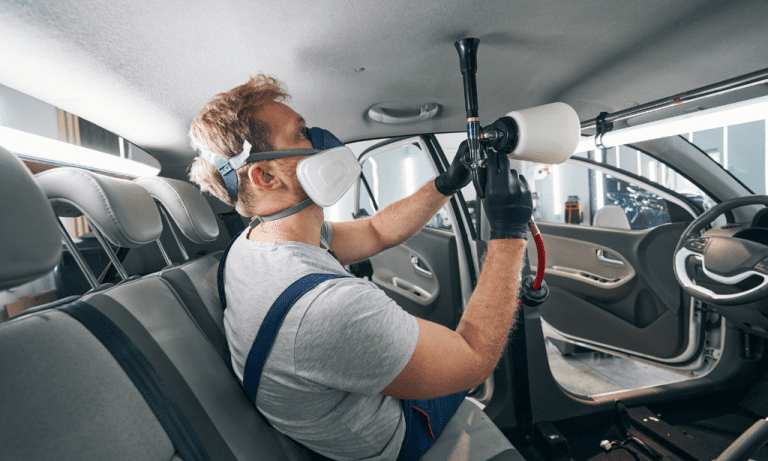Will Lacquer Thinner Harm Your Car Paint? [Discover the Truth]
Lacquer thinner can damage car paint as it is a strong solvent that can dissolve the paint. However, its impact can vary depending on the type of paint and the duration of exposure.
It is important to exercise caution and avoid using lacquer thinner near car paint to prevent any potential damage. Car owners take pride in maintaining the pristine appearance of their vehicles, and any potential damage to the paint is a cause for concern.
One such concern is the use of lacquer thinner on car paint. Lacquer thinner is a powerful solvent commonly used in painting and refinishing projects to dissolve and remove lacquer-based paints.
However, its strong chemical properties raise questions about its potential impact on car paint. In this article, we will explore whether lacquer thinner can damage car paint and the factors that influence its effects.
Understanding this can help car owners make informed decisions when it comes to maintaining their vehicle’s exterior. So, let’s delve into the details.
What Is Lacquer Thinner?
Lacquer thinner is a common substance used in various industries, including the automotive industry. While it serves multiple purposes, many people wonder if it can potentially damage car paint. In order to address this concern, it is important to first understand what lacquer thinner is and its composition.
Definition And Composition Of Lacquer Thinner
Lacquer thinner is a volatile solvent that is widely used in automotive refinishing. It is primarily composed of a mixture of solvents such as toluene, xylene, and acetone. These solvents work together to dissolve different types of paints and coatings, making it easier to remove them.
Here are the key points to remember about the definition and composition of lacquer thinner:
- Lacquer thinner is a volatile solvent commonly used in the automotive industry.
- It is composed of a mixture of solvents including toluene, xylene, and acetone.
- These solvents work together to dissolve paints and coatings.
Common Uses Of Lacquer Thinner In Automotive Industry
Lacquer thinner finds various applications in the automotive industry, where it plays a crucial role in the refinishing process. Understanding its common uses can help shed light on its potential impact on car paint.
Here are some key points to know about the common uses of lacquer thinner in the automotive industry:
- Diluting paints: Lacquer thinner is commonly used to dilute lacquer-based paints, allowing for smoother application and better coverage.
- Cleaning surfaces: It is often used to clean and degrease automotive surfaces before applying paint or coatings.
- Removing paint: Lacquer thinner is effective in removing old paint or clear coats, making it easier to restore or refinish car surfaces.
- Equipment cleaning: It is also used to clean spray guns, brushes, and other painting equipment after use.
Lacquer thinner is a versatile solvent widely used in the automotive industry. It serves various purposes such as thinning paints, cleaning surfaces, and removing old paint. While its use can have significant benefits, it is important to handle it with care to avoid any potential damage to car paint.
Understanding Car Paint Coatings
Car paint coatings play a crucial role in protecting your vehicle’s exterior and maintaining its appearance. Understanding the different types of car paint coatings and how they safeguard your car’s paint job is essential for any car owner. In this section, we will explore the various types of car paint coatings and delve into how they provide protection for your vehicle.
Types Of Car Paint Coatings
- Clear coats: These are the most common type of car paint coatings and are applied as a top layer to provide shine and protection. Clear coats act as a barrier against uv rays, moisture, and contaminants.
- Ceramic coatings: Ceramic coatings are highly durable and offer exceptional protection against scratches, chemical stains, and oxidation. They form a protective layer that bonds with the car’s paint, providing long-lasting protection.
- Polymer sealants: Polymer sealants serve as a shield between your car’s paint and the elements, protecting it from uv rays, acid rain, and bird droppings. They offer a glossy finish, enhancing the overall appearance of the vehicle.
- Wax coatings: Wax coatings are an affordable and popular option for car paint protection. They provide a temporary protective layer that shields against minor scratches and provides a glossy shine.
How Car Paint Coatings Protect Your Vehicle
- Uv protection: Car paint coatings act as a shield against harmful ultraviolet (uv) rays from the sun, preventing damage and fading to your car’s paint job.
- Scratch resistance: The protective layer created by car paint coatings helps guard your vehicle against scratches from everyday wear and tear.
- Chemical resistance: Car paint coatings provide protection against various chemical stains and contaminants, such as acid rain, tree sap, bird droppings, and harsh cleaning products.
- Ease of cleaning: Coated surfaces are easier to clean as they repel dirt and grime, making it effortless to maintain the appearance of your vehicle.
- Longevity: Car paint coatings offer a longer-lasting solution compared to traditional waxes or polishes, ensuring your car’s paint remains protected for an extended period.
Understanding the different types of car paint coatings and how they protect your vehicle is crucial in maintaining its aesthetic appeal. Whether you opt for clear coats, ceramic coatings, polymer sealants, or wax coatings, investing in protective coatings will safeguard your car’s paint and preserve its value in the long run.
Take the time to choose the right coating for your needs, and enjoy the peace of mind knowing your vehicle is well-protected.
Effects Of Lacquer Thinner On Car Paint
Lacquer thinner is a commonly used solvent in automotive refinishing and repair. While it can be highly effective in removing paint, adhesives, and other substances, there is a lingering concern among car owners about its potential for damaging car paint.
We will discuss the effects of lacquer thinner on car paint, the potential risks and damages it can cause, and the factors that determine the extent of damage.
Potential Risks And Damages Caused By Lacquer Thinner:
- Lacquer thinner contains powerful solvents that can dissolve the protective clear coat on car paint.
- Excessive use or prolonged exposure to lacquer thinner can result in the removal or discoloration of the paint itself.
- The solvents in lacquer thinner can penetrate the paint layers and damage the underlying primer or metal surface of the car.
- Lacquer thinner can also dissolve the adhesive bonds of car decals, stripes, or detailing, leading to their detachment or distortion.
- Inappropriately using lacquer thinner on plastic parts of a car can cause them to warp, melt, or lose their original luster.
Factors That Determine The Extent Of Damage:
- The type and age of the car paint: Different car paints have varying levels of chemical resistance, with newer clear coats being more resilient to lacquer thinner.
- The thickness of the paint layers: Thicker paint layers provide more protection against the solvent’s penetration.
- Duration of contact: The longer lacquer thinner is in contact with the paint, the greater the chance of damage.
- Concentration and application method: Diluted or misapplied lacquer thinner can cause less severe damage compared to using undiluted or improperly applied solvents.
Examples Of Car Paint Damage Caused By Lacquer Thinner:
- Fading or discoloration of paint: Lacquer thinner can strip the paint of its original color, resulting in a faded or patchy appearance.
- Peeling or lifting of clear coat: The solvents in lacquer thinner can dissolve the clear coat, causing it to bubble, peel, or lift away from the paint surface.
- Blistering or bubbling: Excessive use of lacquer thinner or prolonged exposure can lead to the formation of bubbles or blisters in the paint layer.
- Removal of decals or detailing: Lacquer thinner can dissolve the adhesive bonds of decals, rendering them loose or removing them entirely.
- Damage to plastic parts: Incorrect application or contact with lacquer thinner can cause plastic parts like bumpers or trims to warp, melt, or lose their shine.
Remember, proper care and caution should always be exercised when using lacquer thinner on your car. It is essential to follow manufacturer instructions and perform a spot test in an inconspicuous area before applying it to the entire surface.
Myths And Misconceptions About Lacquer Thinner
Lacquer thinner is a commonly used solvent in various industries, including automotive. However, there are several myths and misconceptions surrounding its effects on car paint. In this section, we will debunk these misconceptions and shed light on the key differences between lacquer thinner and other solvents.
Debunking Common Misconceptions About Lacquer Thinner:
- Myth: Lacquer thinner will damage car paint.
- Fact: Lacquer thinner is not inherently damaging to car paint. When used properly and in moderation, it can effectively remove contaminants and old paint layers without causing harm. However, excessive use or prolonged exposure may lead to paint deterioration, so it’s crucial to follow recommended guidelines.
- Myth: Lacquer thinner is identical to paint thinner.
- Fact: Although lacquer thinner and paint thinner are both solvents, they are not the same. Lacquer thinner is specifically formulated to dissolve lacquer-based paints, while paint thinner is designed for a broader range of oil-based paints. It’s important to distinguish between the two and use the appropriate solvent for your specific paint type.
Differentiating Between Lacquer Thinner And Other Solvents:
- Lacquer thinner:
- Effectively dissolves and removes lacquer-based paint.
- Evaporates quickly, leaving minimal residue.
- Can cause paint deterioration if used excessively or on incompatible surfaces.
- Paint thinner:
- Suitable for removing oil-based paints.
- Has a slower evaporation rate, allowing for a longer working time.
- May leave behind a residue that requires thorough cleaning.
When it comes to using lacquer thinner on car paint, understanding the facts is essential. Proper knowledge and careful application can help you maintain the integrity of your car’s paint job without causing any damage.
Steps To Safely Remove Lacquer Thinner From Car Paint
When it comes to maintaining the appearance of your car, it’s important to be aware of potential risks that could damage its paint. One such risk is lacquer thinner, a strong solvent commonly used for removing paint and cleaning surfaces.
If not handled carefully, lacquer thinner can actually do more harm than good to your car’s paint job. We will focus on the steps you can take to safely remove lacquer thinner residue from car paint, minimizing any potential damage in the process.
Immediate Actions To Minimize Damage:
- Act quickly: The first step is to immediately address any contact between lacquer thinner and your car’s paint. The longer the chemical sits on the surface, the more damage it can potentially cause.
- Rinse with water: Rinse the affected area with water as soon as possible. This will help dilute and remove any residual lacquer thinner, minimizing its impact on the paint.
- Use a mild detergent: If water alone is not enough to remove the lacquer thinner, you can mix a small amount of mild detergent with water and gently scrub the surface, using a soft sponge or cloth. Be sure to rinse thoroughly afterwards.
- Inspect for damage: Once you have removed the lacquer thinner residue, carefully inspect the paint for any signs of damage. Look for changes in color, texture, or any peeling or bubbling. If damage is evident, it may be necessary to seek professional assistance.
Safe And Effective Ways To Remove Lacquer Thinner Residue From Car Paint:
- Use rubbing alcohol: Dampen a clean cloth or cotton ball with rubbing alcohol and gently wipe the affected area. The alcohol will help dissolve any remaining lacquer thinner and evaporate quickly, leaving little to no residue behind.
- Clay bar treatment: Clay bars are designed to remove contaminants from the surface of car paint. Moisten the clay bar with a lubricant, and then gently glide it over the affected area. This will effectively lift any remaining lacquer thinner residue.
- Polish and wax: After removing the lacquer thinner, it’s important to restore the shine and protect the paint. Apply a high-quality car polish to remove any swirl marks or micro-scratches, followed by a protective wax to provide a layer of defense against future damage.
By following these steps, you can safely and effectively remove lacquer thinner residue from your car’s paint, minimizing the risk of any long-term damage. Remember to always exercise caution when handling strong solvents and consider seeking professional help if you are unsure about the process or if any damage is evident.
With the right approach, you can maintain the pristine appearance of your car for years to come.
Preventing Car Paint Damage From Lacquer Thinner
Lacquer thinner is a commonly used solvent in automotive repair and painting, but there are concerns about its potential to damage car paint. If you’ve ever wondered whether lacquer thinner can harm your vehicle’s pristine finish, this blog post is here to answer your questions.
In this section, we’ll focus on preventive measures to avoid accidental exposure and best practices for handling and storing lacquer thinner to prevent any harm to your car’s paintwork.
Precautionary Measures To Avoid Accidental Exposure:
- Always wear protective gloves and safety goggles when working with lacquer thinner.
- Make sure to work in a well-ventilated area or wear a respirator if ventilation is limited.
- Avoid any contact with your skin, as lacquer thinner can cause irritation and dryness.
- If you accidentally spill lacquer thinner on your skin, wash the area thoroughly with soap and water.
- Keep lacquer thinner away from open flames and sources of ignition, as it is highly flammable.
Best Practices For Handling And Storing Lacquer Thinner:
- Store lacquer thinner in a cool, dry place, away from sunlight and heat sources.
- Seal the container tightly to prevent evaporation and minimize the risk of spillage.
- Keep lacquer thinner away from children and pets, as ingestion or inhalation can be harmful.
- Do not use lacquer thinner near painted surfaces unless absolutely necessary, as it may cause discoloration or damage to the paint.
- When using lacquer thinner for cleaning purposes, test it on a small, inconspicuous area first to ensure it does not affect the paint.
By following these precautionary measures and best practices, you can minimize the risk of damaging your car’s paintwork when working with lacquer thinner. It’s important to prioritize safety and take the necessary steps to protect both yourself and your vehicle.
Conclusion
Using lacquer thinner on your car paint can have detrimental effects. The strong chemicals in lacquer thinner can strip away the protective layers of wax and paint, causing the paint to fade or peel. This can result in a dull and worn-out appearance for your car.
The solvents in lacquer thinner can also react with the paint, leading to discoloration or damage. It’s crucial to exercise caution when dealing with any chemical on your car’s paintwork. If you’re looking to remove stubborn stains or paint marks, it’s best to resort to safer alternatives such as rubbing alcohol or specialized automotive paint cleaners.
By being mindful of the products you use and following proper car care techniques, you can ensure your car paint remains in pristine condition for years to come. Take care of your investment and give your car the protection it deserves.
- Protecting Your Truck Bed: A Guide To Truck Bed Covers - July 14, 2025
- Finding The Right 88-98 Chevy Truck Bed Cover - July 14, 2025
- Finding The Right 88-98 Chevy Truck Bed Cover - July 14, 2025






